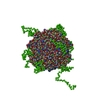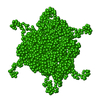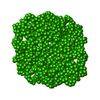+Search query
-Structure paper
| Title | SAXS Structural Studies of Dps from Deinococcus radiodurans Highlights the Conformation of the Mobile N-Terminal Extensions. |
|---|---|
| Journal, issue, pages | J Mol Biol, Vol. 429, Issue 5, Page 667-687, Year 2017 |
| Publish date | Mar 10, 2017 |
 Authors Authors | Sandra P Santos / Maxime G Cuypers / Adam Round / Stephanie Finet / Theyencheri Narayanan / Edward P Mitchell / Célia V Romão /    |
| PubMed Abstract | The radiation-resistant bacterium Deinococcus radiodurans contains two DNA-binding proteins from starved cells (Dps): Dps1 (DR2263) and Dps2 (DRB0092). These are suggested to play a role in DNA ...The radiation-resistant bacterium Deinococcus radiodurans contains two DNA-binding proteins from starved cells (Dps): Dps1 (DR2263) and Dps2 (DRB0092). These are suggested to play a role in DNA interaction and manganese and iron storage. The proteins assemble as a conserved dodecameric structure with structurally uncharacterised N-terminal extensions. In the case of DrDps1, these extensions have been proposed to be involved in DNA interactions, while in DrDps2, their function has yet to be established. The reported data reveal the relative position of the N-terminal extensions to the dodecameric sphere in solution for both Dps. The low-resolution small angle X-ray scattering (SAXS) results show that the N-terminal extensions protrude from the spherical shell of both proteins. The SAXS envelope of a truncated form of DrDps1 without the N-terminal extensions appears as a dodecameric sphere, contrasting strongly with the protrusions observed in the full-length models. The effect of iron incorporation into DrDps2 was investigated by static and stopped-flow SAXS measurements, revealing dynamic structural changes upon iron binding and core formation, as reflected by a quick alteration of its radius of gyration. The truncated and full-length versions of DrDps were also compared on the basis of their interaction with DNA to analyse functional roles of the N-terminal extensions. DrDps1 N-terminal protrusions appear to be directly involved with DNA, whilst those from DrDps2 are indirectly associated with DNA binding. Furthermore, detection of DrDps2 in the D. radiodurans membrane fraction suggests that the N-terminus of the protein interacts with the membrane. |
 External links External links |  J Mol Biol / J Mol Biol /  PubMed:28088481 PubMed:28088481 |
| Methods | SAS (X-ray synchrotron) |
| Structure data |  SASDBF7:  SASDBG7:  SASDBH7: |
| Source |
|
 Movie
Movie Controller
Controller Structure viewers
Structure viewers About Yorodumi Papers
About Yorodumi Papers



 Deinococcus radiodurans r1 (radioresistant)
Deinococcus radiodurans r1 (radioresistant)